
In which a new baby is delivered – 500 kg!
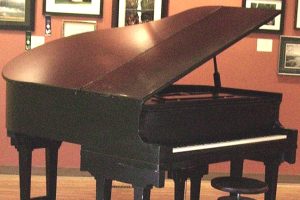
There was a very old grand piano in the Main Gallery. Steeve tried playing a few notes on it, but it was in such disrepair that it was impossible to use. I therefore engaged the services of a very fine piano tuner, Wes Slater, to repair it, tune it, and get it ready for Music in the Gallery.
But it was not to be… He told me that the frame (the part of the instrument that holds the strings) was too old to support the tension, the base board was cracked beyond repair, the keys would need replacing, as would the hammers – in short, nothing was salvageable. His advice: throw it away and purchase a new one.
And so we started fundraising. The first step was to put together a music committee. For this, I got June Scandiffio, one of the Gallery’s longest supporting volunteers, Lori Mitchell, also a volunteer as well as an excellent local painter, and Steeve, my husband, because his training is in music, and among other things he is a pianist.
We discussed piano type, size, possible uses, maintenance, and budget. We decided against an upright piano: they clearly have a front and a back; for any audience sitting behind the instrument, it would be like going to the opera and sitting behind the stage!
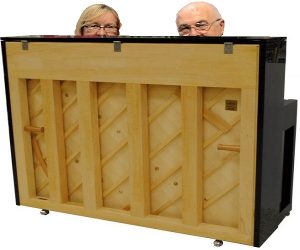
A grand piano can have audience on three sides with no problem – all around even, if the piano lid is removed. But what size would be appropriate? They range from baby grands, good for a domestic living room, up to massive concert grands, good for concert halls seating 8000 people.
With some research, we discovered the ideal size, an instrument with sound that would easily fill the Gallery space but would not occupy too much of the Main Gallery floor.
The instrument would be very useful, not only for piano concerts (I should say ‘recital’), but also for voice or violin recitals, or even choir concerts – the piano is the preferred accompaniment instrument for virtually everything.
Maintenance would be easy for a new instrument, with periodic tuning the only requirement.
We searched around, and found the perfect instrument. Budget was the final point.
Now we had to search again, and find the perfect sponsors! And we succeeded, largely due to the efforts of Lori Mitchell. Steeve and I chipped in with the last few thousand, and suddenly the Gallery was the proud owner of a beautiful new grand piano!
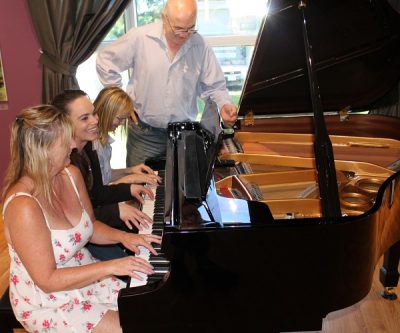

We have a piano. Now we need music. I discussed the options with Steeve, my husband, and he started by outlining the problems. This was not a negative thing; you cannot organize an event unless you know the potential limitations.
First, the piano takes space. Allowing for a few feet around the instrument, it needs ten-by-ten feet – one hundred square feet. A chair takes about ten square feet, and so the piano reduces the audience capacity by ten people.
Further, the Main Gallery has a pillar in the middle of the floor, which creates a ‘blind spot’ behind it.
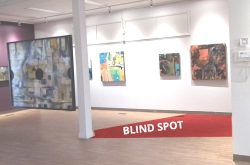
This reduces the available space by another ten chairs. Now we need some simple math! How many chairs can we reasonably fit into the remaining space? We resorted to drawing a diagram of the Main Gallery floor space, and adding pictures of chairs…
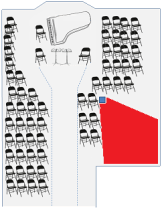
It was great fun doing this! But also very practical: we need to know how much money we can make for the gallery after all expenses are paid. Expenses divided by number of seats gives us the minimum ticket price!
It turns out that we can reasonably fit sixty chairs (in fact, we got less and less reasonable as time went on, and for some events we crammed in eighty chairs. No one seemed to mind…). Expenses include musicians’ honoraria, food and drink, and printing programmes. By selling sixty tickets at $25, we would make a profit of about $600 for the Arts Centre.
We decided to call the music series Performance!, and each show would focus on a country or a type of music, with the title A Taste of…
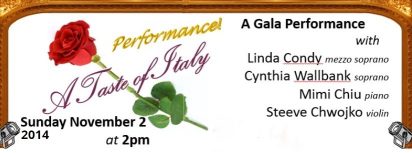
The first event was A Taste of Italy. We approached three musicians – Linda Condy and Cynthia Wallbank, who are singers, and Mimi Chiu, a pianist. They all agreed to perform for free. Then Sobeys in Sutton donated over $100 of food and drink for free! Volunteers chipped in with homemade cookies and sandwiches, and so we had no expense for catering. Ticket sales went well, then went very well, and we quickly reached our self-imposed limit of sixty.
All in all, we made over $1000 for the Arts Centre!
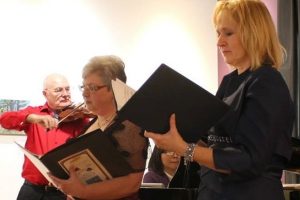

In 2013 Barbara Mitchell, the Director of Collections and Donations at the York Wilson Foundation for The Arts, had discussed with Heather Fullerton, the Executive Director at the GAC, a bequest of thirty paintings by York Wilson. This was very exciting, because he was one of Canada’s most distinguished artists, with works held in collections around the world – for example, the Italian tenor Luciano Pavarotti, and the Uffizi Gallery in Florence.
In 2014 The paintings arrived, and I decided, for this first showing of such a magnificent addition to our Permanent Collection, to extend the duration of the exhibition from the usual length of six weeks, to eight weeks.
I also felt that people would be bemused by the abstract style of these works, so very different from the art of Chiarandini, Smith, and Zsolt.

I therefore decided to write a catalogue where each painting would be explained and put into a context that would make it more understandable.
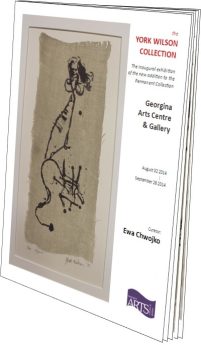
The twenty-page catalogue included biographical information, explanations of geography, images of all the works on display as well as others not in the collection, and of course notes on what to look for in each painting.
It was a great success!! People followed the suggestion on the third page of the catalogue: first, stroll around the exhibition, see what you like or don’t like. Next, sit down and read the catalogue, then walk around again.
Laurence Ritchie, one of the founders of the GAC and chair of the Board of Directors, summed up well the impact of the catalogue: “I walked around and saw things that I didn’t understand, shapes that seemed to have no meaning and colours that seemed slapped together haphazardly. Then I sat down in the middle of the gallery and read the catalogue through. Suddenly I understood what York Wilson was doing, and why the lines and the forms were put together in just that way! I walked around again, with the catalogue. I didn’t necessarily like everything I saw, but I understood it! It all looked so natural and logical.”
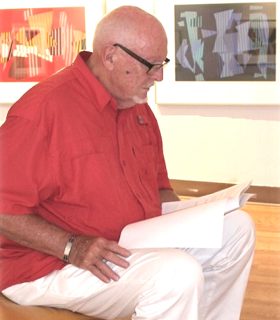
Ideally the exhibition would have been extended for an extra month, but others were awaiting their turn on the walls of the Gallery, and so, after two months, York Wilson had to go down to the storage room.
But of course, after that he was a regular visitor to THE WALL!
Barbara Mitchell was so impressed by the exhibition that she subsequently donated three works by Kay Murray Weber, a renowned Canadian artist, and the first woman to be admitted to the Royal Canadian Academy of Arts. It seems that Barbara Mitchell was reading my mind – my dream was to expand our Permanent Collection to include works by a Canadian woman artist, in order to balance the existing three-hundred-strong collection of works by four distinguished men.

One of my objectives as curator was to make the GAC better known to other art galleries around the Toronto area. By doing this, I hoped to be able to exchange works of art, to bring other artists work to Georgina and allow Georgina artists to exhibit elsewhere.
I decided to host a ‘curators’ luncheon’ in the fall of 2014, and to invite curators and art professionals. To this end, I wrote to galleries that were close – Newmarket, Aurora, Markham – as well as galleries that were farther afield – Orillia, and Pickering. I also decided to contact galleries that were too far away, where I knew that the curator or director would not come, but at least I could tell them about our Arts Centre. I wrote to a large gallery in Oakville, for example.
I got an overwhelming response, and only one or two gallery representatives could not make it. My greatest surprise was greeting the director of the Oakville Art Gallery! He had made a two-hour car ride, just to see our gallery.
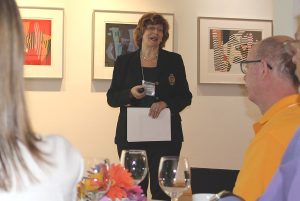
Barbara Mitchell was our guest speaker, then each person stood and introduced themselves. And they all said that they had not suspected that such a dynamic and lively Arts Centre existed on the shores of Lake Simcoe!
The event was a great success, and made our gallery name known throughout the North York region and beyond.
